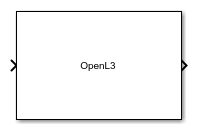OpenL3
Libraries:
Audio Toolbox /
Deep Learning
Description
The OpenL3 block leverages a pretrained convolutional neural network that extracts feature embeddings from audio signals. These embeddings are powerful audio representations that can be used for tasks such as classification. This block requires Deep Learning Toolbox™.
Ports
Input
Output
Parameters
Block Characteristics
Data Types |
|
Direct Feedthrough |
|
Multidimensional Signals |
|
Variable-Size Signals |
|
Zero-Crossing Detection |
|
References
[1] Cramer, Jason, et al. "Look, Listen, and Learn More: Design Choices for Deep Audio Embeddings." In ICASSP 2019 IEEE International Conference on Acoustics, Speech and Signal Processing (ICASSP), IEEE, 2019, pp. 3852-56. DOI.org (Crossref), doi:/10.1109/ICASSP.2019.8682475.
Extended Capabilities
Version History
Introduced in R2022b
